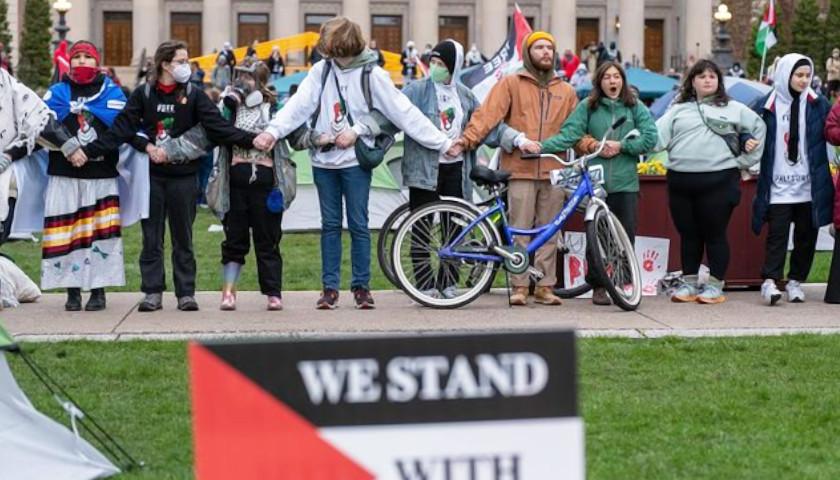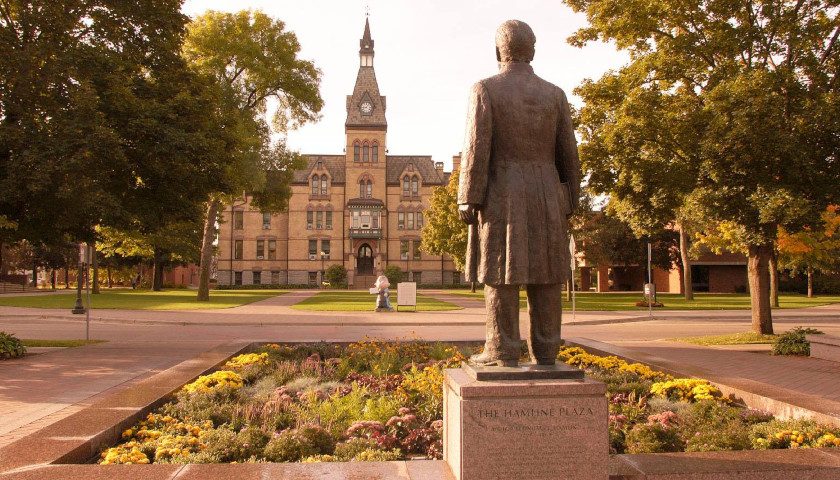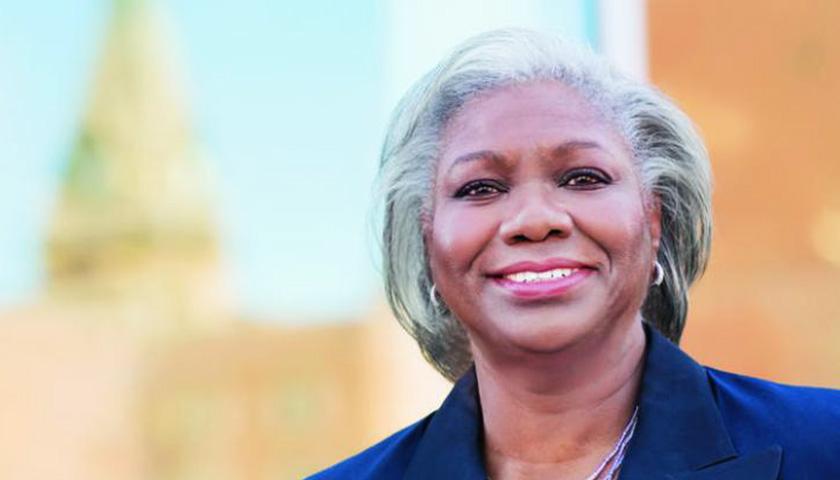by Greg Piper
Two liberal arts schools six minutes from each other in St. Paul, Minn., have explicitly subordinated Islam-related academic and artistic freedom to the feelings of Muslim students in recent months, alarming faculty both nationwide and closer to home.
Macalester College temporarily shut down and then added curtains to an art exhibit depicting partially exposed figures in hijabs and niqabs “to prevent unintentional or non-consensual viewing” after Muslim students complained, the administration said in an email Feb. 6 excerpted by Minnesota immigrant news nonprofit Sahan Journal.
Hamline University reversed its pledge to renew adjunct art history professor Erika Lopez Prater’s contract after she showed students Muslim-commissioned depictions of the Prophet Muhammad, saying “respect for the observant Muslim students in that classroom should have superseded academic freedom.”
Prater spoke at the Jan. 27 opening of Macalester’s “Woman Life Freedom” art exhibit by Portland State University art professor Taravat Talepasand, saying it “responsibly” demonstrates how to deal with supposedly blasphemous subject matter.
While Salem State University also put curtains around an anti-Donald Trump exhibit in 2016, Macalester’s rationale appears to be original in the history of campus art censorship, according to the Foundation for Individual Rights and Expression.
“It’s a comically bad lesson to teach students” that words and images they encounter are “an exercise of their own consent,” FIRE Director of Targeted Advocacy Sarah McLaughlin wrote in a blog post Thursday. Its invocation against an exhibit that “protests the violation of women’s rights is an added layer of absurdity.”
“It’s a comically bad lesson to teach students that they should expect the words and images they encounter through the course of their lives to be understood as an exercise of their own consent, and not another’s right to free expression.” https://t.co/lMnIKDyOEq
— Talia Barnes (@RealFakeTalia) February 9, 2023
It is “deeply problematic” that both institutions’ statements are “trafficking in this language of harm and hurt,” history professor Amna Khalid of Minnesota’s Carleton College, who helped build support for Prater, told Just the News Friday.
“Should that become the basis of college policies? At some point this turns into a farce,” Khalid said, noting she has received similar “questions about my pedagogical strategy or how I present material.”
As a Muslim, Khalid worries that colleges are taking the “more conservative brand of Islam” as “representative of all Muslims” and possibly setting the stage for worse Islamophobia.
Two weeks before the Macalester blowup, Khalid moderated a campus panel on “Teaching Islam and Islamic Art in the Age of Inclusion,” which she said drew around 250 attendees. While she let the Carleton Muslim Students Association make a statement at the opening, Khalid declined its request to serve on the panel, which featured Carleton, Macalester and University of Minnesota faculty.
The broader threat is the commercialization of diversity, equity and inclusion — “DEI Inc.” — which has “unavoidable tensions” with academic freedom that “PR-driven wishful thinking” can’t erase, Khalid wrote in The Chronicle of Higher Education Feb. 6.
Another Islamic art controversy at a St. Paul liberal arts college. But a very different response from both students and the administration. Reporting this story was like a trip through the multiverse. My latest: https://t.co/7ygBKO8T6M
— Becky Zosia Dernbach (@bzosiad) February 9, 2023
The two controversies diverge in important ways, likely making Macalester less vulnerable than Prater to reputational and legal fallout.
Macalester didn’t portray Muslims as a monolith or make sweeping statements about what Islam forbids. During a “short pause” of Talepasand’s exhibit over the weekend, it sought out “multiple perspectives from Muslim communities on campus” before settling on a content warning and curtains, later replaced by purple construction paper and frosted windows.
Hamline called Prater’s pedagogical decision, which was previewed in the syllabus and in that day’s class, “undeniably … Islamophobic,” and it hosted a “community conversation” where a local Muslim leader compared Prater’s lesson to “pedophilia art.”
Both are cited in Prater’s lawsuit against the school, which she refiled Thursday minus breach-of-contract claims while keeping “religious discrimination, defamation, retaliation, and intentional infliction of emotional distress,” her lawyer David Redden told Sahan Journal.
Prater had agreed to Hamline’s motion for transfer to federal court so she could voluntarily dismiss and refile in the same state court “where the case belongs” because it was the “faster of the available options,” Redden said.
Hamline didn’t respond to Just the News queries, but its lawyer Merk Berhow told the Star Tribune it will “respond accordingly.”
What the disputes share is racial and cultural clashes under the surface of differing interpretations of Islam. The artists have Persian backgrounds, while the Muslim students who led both cancel campaigns are black, and the state’s Muslim population is disproportionately Somali-American, including Democratic Rep. Ilhan Omar.
Iranian students at Macalester came to Talepasand’s defense at a Feb. 3 meeting, participant Kalid Ali told Sahan Journal.
“This is NOT a question of support for Iranian Women,” petition creator Ikran Noor, who wears a hijab on campus, wrote on Instagram. (The petition cannot be viewed without her approval.)
Noor told the Journal she simply wanted Macalester to remove the more explicit works. Her Instagram post ties the “objectification, fetishization and overt sexualization of Hijabis” to “the rise of sexual assault against Muslim women.”
—talk about niqabs around art. I find the black curtains themselves eye popping. pic.twitter.com/HAyIsTXX3L
— Hotspvrre (@Hotspvrre) February 9, 2023
Talepasand, whose parents immigrated to Oregon during the Iranian Revolution, inserts multiple social and political references from the country in her artwork, which “explores the cultural taboos that reflect on gender and political authority.”
The hijab and niqab works, which variously feature cartoonish breasts and exposed lingerie, refer to an “Iranian writer and rock-and-roll groupie” she knows as well as Paleolithic art and Iran’s obsession with cosmetic surgery, Talepasand told the Journal.
Her other works are highly political and sometimes unsettling. The exhibit not only alludes to Sudan’s prosecution of a British teacher for letting her students name a teddy bear “Muhammad,” but includes a painting of a man beheading two women.
Talepasand said it took three years of discussions with Macalester’s Law Warschaw Gallery before she had a signed contract last summer. She called the weekend closure and black curtains “censorship” and the gallery’s placement of Noor’s flyer for her petition on the exhibit door a “violation.”
Macalester does not appear to have published the statement it shared with the Journal or acknowledged the controversy on its website or social media, and did not respond to queries.
The college is instead promoting its designation as a “top producer of Fulbright U.S. scholars” and its President Suzanne Rivera’s election to the American Association of Colleges and Universities’ board of directors.
– – –
Greg Piper has covered law and policy for 15 years, with a focus on tech companies, civil liberties and higher education. Piper joined Just the News from The College Fix, where he trained college students in journalism and covered the biggest controversies on campus, from free speech and academic freedom battles to sexual misconduct proceedings and litigation.
Photo “Muslim Woman” by Yusril Khaerul Muslim.






Wait … so banning books to protect christians, which I totally agree with, is ok, but banning nudity in public to protect muslims teens is not OK?! Are you people rtrdd?